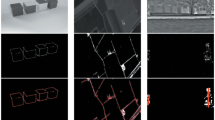Abstract
The a contrario approach is a principled method for making algorithmic decisions that has been applied successfully to many tasks in image analysis. The method is based on a background model (or null hypothesis) for the image. This model relies on independence assumptions and characterizes images in which no detection should be made. It is often image dependent, relying on statistics gathered from the image, and therefore adaptive. In this paper we propose a generalization for background models which relaxes the independence assumption and instead uses image dependent second order properties. The second order properties are accounted for thanks to graphical models. The modified a contrario technique is applied to two tasks: line segment detection and part-based object detection, and its advantages are demonstrated. In particular, we show that the proposed method enables reasonably accurate prediction of the false detection rate with no need for training data.














Similar content being viewed by others
References
Chow, C. K., & Liu, C. N. (1968). Approximating discrete probability distributions with dependence trees. IEEE Transactions on Information Theory, 14, 462–467.
Cormen, T. H., Leiserson, C. E., & Rivest, R. L. (1990). Introduction to algorithms. Cambridge: MIT Press.
Dalal, N., & Triggs, B. (2005). Histograms of oriented gradients for human detection. In Proc. IEEE conf. comp. vision patt. recog. (pp. 886–893).
Desolneux, A., Moisan, L., & Morel, J. M. (2000). Meaningful alignments. International Journal of Computer Vision, 40(1), 7–23.
Desolneux, A., Moisan, L., & Morel, J. M. (2001). Edge detection by Helmholtz principle. Journal of Mathematical Imaging and Vision, 14(3), 271–284.
Desolneux, A., Moisan, L., & Morel, J. M. (2008). From gestalt theory to image analysis. Berlin: Springer.
Fergus, R., Perona, P., & Zisserman, A. (2007). Weakly supervised scale-invariant learning of models for visual recognition. International Journal of Computer Vision, 71(3), 273–303.
Flenner, A., & Hewer, G. A. (2011). Helmholtz principle approach to parameter free change detection and coherent motion using exchangeable random variables. SIAM Journal on Imaging Sciences, 4(1), 243–276.
Galerne, B., Gousseau, Y., & Morel, J.-M. (2010). Random phase textures: theory and synthesis. IEEE Transactions on Image Processing, 20(1), 257–267.
Gousseau, Y., & Roueff, F. (2007). Modeling occlusion and scaling in natural images. Multiscale Modeling & Simulation. SIAM Interdisciplinary Journal, 6(1), 105–134.
Grimmett, G., & Stirzaker, D. (2001). Probability and random processes (3rd ed.). Cambridge: Oxford University Press.
Grompone von Gioi, R., Jakubowicz, J., Morel, J.-M., & Randall, G. (2008). On straight line segment detection. Journal of Mathematical Imaging and Vision, 32, 313–347.
Grompone von Gioi, R., Jakubowicz, J., Morel, J.-M., & Randall, G. (2010). Lsd: A fast line segment detector with a false detection control. IEEE Transactions on Pattern Analysis and Machine Intelligence, 32, 722–732.
Grosjean, B., & Moisan, L. (2009). A-contrario detectability of spots in textured backgrounds. Journal of Mathematical Imaging and Vision, 33(3), 313–337.
Konishi, S., Yuille, A. L., Coughlan, J. M., & Zhu, S. C. (2003). Statistical edge detection: learning and evaluating edge cues. IEEE Transactions on Pattern Analysis and Machine Intelligence, 25(1), 57–74.
Lowe, D. G. (2004). Distinctive image features from scale-invariant keypoints. International Journal of Computer Vision, 60(2), 91–110.
Moisan, L., & Stival, B. (2004). A probabilistic criterion to detect rigid point matches between two images and estimate the fundamental matrix. International Journal of Computer Vision, 57(3), 201–218.
Muse, P., Sur, F., Cao, F., Gousseau, Y., & Morel, J. M. (2006). An a contrario decision method for shape element recognition. International Journal of Computer Vision, 69(3), 295–315.
Pearl, J. (1988). Probabilistic reasoning in intelligent systems: networks of plausible inference. San Mateo: Morgan Kaufman.
Rabin, J., Delon, J., & Gousseau, Y. (2009). A statistical approach to the matching of local features. SIAM Journal on Imaging Sciences, 2(3), 931–958.
Rajashekar, U., Bovik, A. C., & Cormack, L. K. (2006). Visual search in noise: revealing the influence of structural cues by gaze-contingent classification image analysis. Journal of Vision, 6(4), 379–386.
Ruderman, D. L. (1994). The statistics of natural images. Network: Computation in Neural Systems, 5, 517–548.
Sabater, N., Morel, J. M., & Almansa, A. (2012). Reliable matches in stereovision. doi:10.1109/TPAMI.2011.207
Sivic, J., Russell, B. C., Efros, A. A., Zisserman, A., & Freeman, W. T. (2005). Discovering objects and their location in images. In Proc. int. conf. comp. vision.
Van Trees, H. L. (1965). Detection, estimation, and modulation theory, part I. New York: Wiley.
Vidal-Naquet, M., & Ullman, S. (2003). Object recognition with informative features and linear classification. In ICCV03 (pp. 281–288).
Weber, M., Welling, M., & Perona, P. (2000). Unsupervised learning of models for recognition. In ECCV00 (pp. 18–32).
Zhang, J., Marszalek, M., Lazebnik, S., & Schmid, C. (2007). Local features and kernels for classification of texture and object categories: a comprehensive study. International Journal of Computer Vision, 73(2), 213–238.
Author information
Authors and Affiliations
Corresponding author
Rights and permissions
About this article
Cite this article
Myaskouvskey, A., Gousseau, Y. & Lindenbaum, M. Beyond Independence: An Extension of the A Contrario Decision Procedure. Int J Comput Vis 101, 22–44 (2013). https://doi.org/10.1007/s11263-012-0543-6
Received:
Accepted:
Published:
Issue Date:
DOI: https://doi.org/10.1007/s11263-012-0543-6




